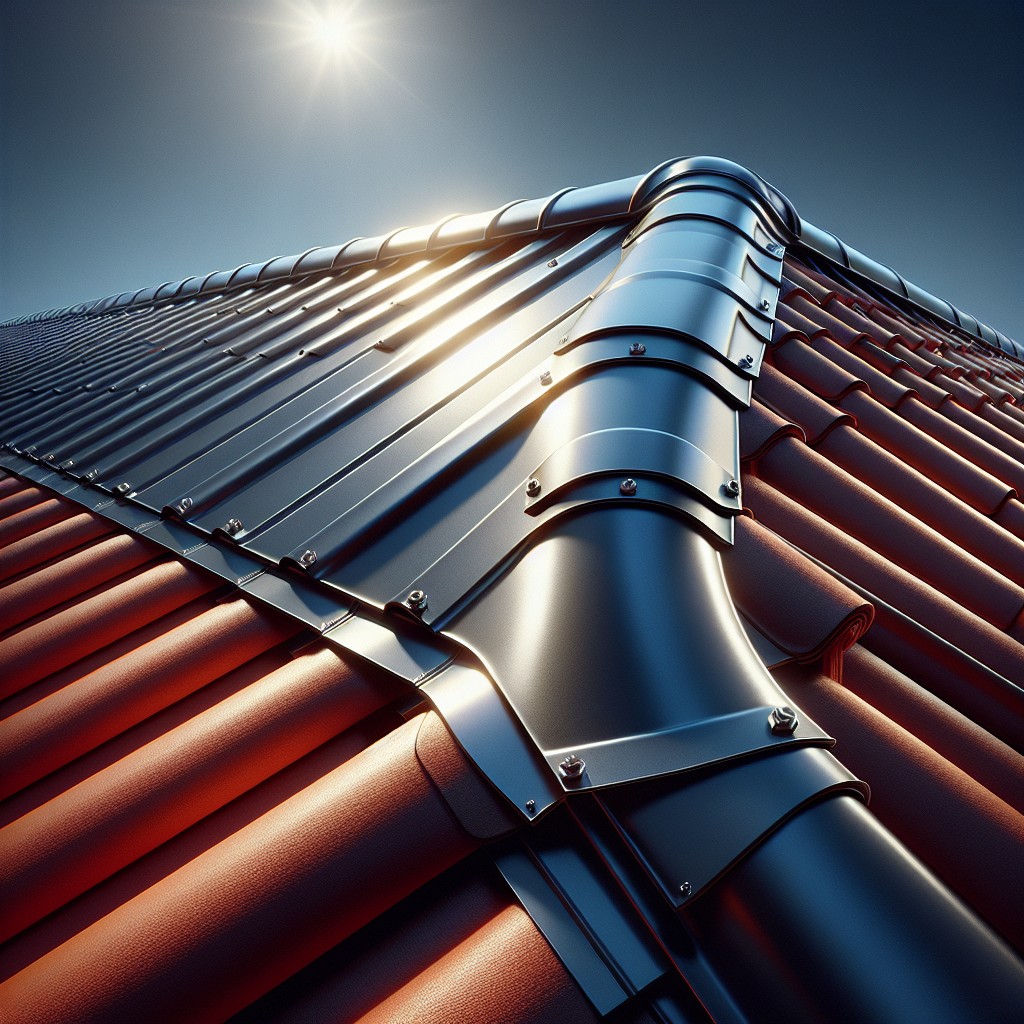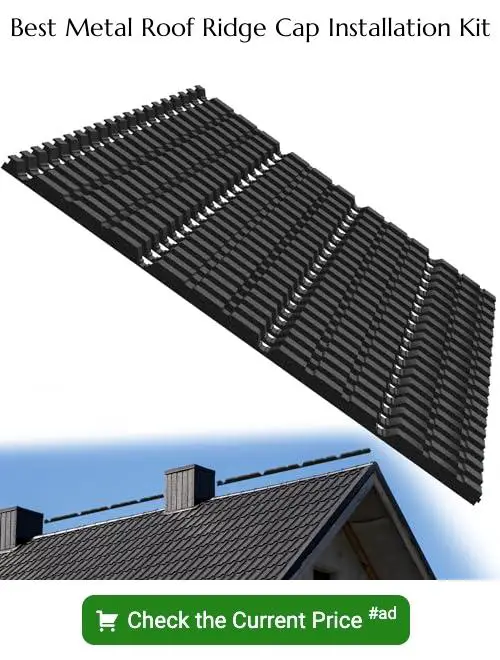Last updated on
Installing a metal roof ridge cap is an essential step because it ensures your roofing system’s highest level of protection against weather and wind damage.
Key takeaways:
- Metal roof ridge caps provide protection against weather and pests.
- Ridge caps enhance the appearance of the roof and increase property value.
- Ridge caps contribute to proper ventilation and prevent moisture buildup.
- Ridge caps should be compatible with the metal roofing system.
- Popular materials for ridge caps include galvanized steel and aluminum.
Importance of Metal Roof Ridge Cap

A properly installed ridge cap is pivotal for sealing the apex of the roof where two slopes meet, thereby preventing water ingress, wind uplift, and the intrusion of pests. Serving as the crowning feature of a metal roofing system, it ensures the longevity and durability of the roof by providing a watertight and aerodynamic finish that complements the overall structure.
It’s also crucial to recognize that ridge caps contribute to the aesthetic appeal of your roof, offering a smooth transition from one roof plane to another. This not only enhances the visual appeal but also increases the overall value of the property.
In terms of performance, the metal ridge cap works effectively to facilitate proper ventilation within the roof structure. A well-ventilated attic space reduces the risk of condensation, which in turn minimizes the potential for mold growth and deterioration of roofing materials, ensuring a healthy and robust roofing system.
Functions of a Ridge Cap

A metal roof ridge cap serves several crucial roles in preserving the overall integrity of your roof:
– It closes the gap at the peak where the two slopes of a metal roof meet, preventing water, snow, and debris from entering and potentially causing damage. – Provides a finished look to the roof’s appearance while aligning with the rest of the metal roofing system aesthetically. – Enhances the weather-tightness of the roof by protecting against wind-driven rain and pest infiltration. – Acts as a critical component of the roof’s ventilation system by potentially incorporating vented features that allow for proper air flow in the attic space. – Helps extend the lifespan of the roof by promoting proper airflow and preventing moisture buildup that can lead to mold, mildew, and rot.The effectiveness of a ridge cap is as much in its correct installation as it is in its design, making it an indispensable part of a well-functioning metal roof.
Compatibility With Metal Roofing Systems
Metal roof ridge caps are specifically designed to work seamlessly with various metal roofing systems. Their compatibility hinges on several key factors:
- Material synergy: The ridge cap metal should match the roof material to ensure uniform thermal expansion and contraction, reducing the risk of leaks and structural fatigue.
- Profile alignment: The shape and size of the ridge cap must align perfectly with the roof panels, which ensures a tight seal and a cohesive appearance.
- Color and finish matching: Manufacturers produce ridge caps in an array of colors and finishes to complement the existing roof panels, promoting a consistent aesthetic.
- Fastening systems: The ridge cap needs to be compatible with the particular fastening system of the roof, whether it’s screw-down panels or standing seam installations, to guarantee a secure attachment.
- Engineering standards: Compliance with industry standards for wind uplift, water penetration, and load-bearing capacity is crucial for any roofing component to function correctly.
When selecting a ridge cap, it’s important to consult with the manufacturer of the existing metal roof to ensure optimal performance and to maintain the integrity of any existing warranties.
Materials and Coatings for Ridge Caps
Galvanized steel and aluminum are popular choices for ridge caps due to their durability and resistance to rust. For environments with harsh weather conditions, manufacturers often recommend steel because of its strength. Aluminum, while not as strong as steel, provides superb corrosion resistance, making it suitable for coastal areas with salty air.
In addition to the base metal, ridge caps may receive protective coatings to further enhance their performance. A zinc or a zinc-aluminum alloy coating, known as galvanization, is commonly applied to steel ridge caps to prevent rust. For added protection, a coating of paint over the galvanized layer can be used, which also provides an opportunity to match the color of the ridge cap with the rest of the roofing system.
Stone-coated steel ridge caps offer an extra layer of protection with a stylish finish. This type consists of a steel core coated with stone chips adhered with an acrylic film, providing a durable and aesthetically pleasing choice.
Lastly, for those seeking more environmentally friendly options, reflective coatings can be applied to metal ridge caps. These coatings are designed to reflect sunlight, reduce heat absorption, and improve energy efficiency.
Ridge Cap Profiles and Dimensions
Selecting the correct ridge cap profile is crucial for both the performance and aesthetic integration with your metal roof. Metal roof ridge caps are designed to match the specific profile of the roofing panels they cover.
Common profiles include:
- Three-Tab Overlap: This is often found on simpler, residential buildings, where the ridge cap may mimic the look of standard shingles for a cohesive appearance.
- Standing Seam: These ridge caps are used with standing seam roofs and provide a clean, modern line that runs continuously along the ridge.
- Corrugated: For corrugated metal roofs, specially designed ridge caps follow the undulating pattern, ensuring a snug fit and adequate protection.
The dimensions of ridge caps play a critical role in ensuring a proper fit and adequate coverage. They should extend past the roof panels on either side to allow for sufficient overlap, usually between 3 and 6 inches. The length of the ridge cap varies, but they are often manufactured in standard lengths, such as 10-foot sections, to make transportation and installation manageable.
When selecting the right dimensions, consider the pitch of your roof. Higher-pitched roofs require ridge caps with a wider flange to span the increased distance between the roof panels. Always refer to the manufacturer’s specifications for guidance to ensure compatibility with your metal roofing system.
Installation Process Overview
Begin by measuring the ridge length to determine the number of caps needed. Careful measurement ensures a seamless fit and adequate material provision without unnecessary waste. Adhere to the panel layout with precision to allow for correct placement of the ridge cap.
Install an underlayment along the ridge as specified by your roofing system, providing an additional layer of protection against moisture and ensuring a solid foundation for the cap installation.
Fasten the ridge cap securely over the peak of the metal roof panels, using recommended fastening screws or nails. Match fastener material to that of the ridge cap to prevent galvanic corrosion.
Overlap ridge cap sections properly, typically by at least 3 inches, to create a continuous barrier that prevents water ingress. Seal the overlapping seams with appropriate sealants or butyl tape, as directed by the roofing manufacturer, to enhance the roof’s weather-tightness.
Trim any excess material at the ends for a clean, finished appearance, ensuring that these end cuts are well-sealed against the elements.
Finally, inspect the installation to confirm that caps are aligned evenly and that all fasteners are installed correctly, with no exposed or unsealed components.
Maintenance and Replacement
Regular maintenance ensures the longevity of a metal roof ridge cap, preventing leaks and other weather-related damages. Inspect ridge caps annually or after severe weather events for signs of wear or damage. Look for loose screws, holes, or corrosion. Sealant used during installation may need reapplication over time to maintain a watertight seal.
When it comes to replacement, it’s important to match the new ridge cap with the existing roof material to ensure a proper fit and maintain aesthetic consistency. Always use appropriate tools and follow the manufacturer’s instructions or hire a professional to guarantee that the new cap is securely installed and the roof’s integrity is preserved.
It’s also crucial to consider the local climate when evaluating the condition of ridge caps. Areas with extreme weather conditions may necessitate more frequent inspections and replacements. If the metal itself is in good condition but the finish has deteriorated, a fresh coat of paint designed for metal roofing can extend the life of the ridge cap.
Aesthetics and Design Options
Metal roof ridge caps not only seal the top of your roof but also offer a chance to enhance its visual appeal. Manufacturers have expanded beyond basic designs to include a variety of styles that range from the traditional to the contemporary. Here are some key considerations:
- Color Matching: Standard options are designed to match the color and finish of your existing metal panels, achieving a seamless look from ridge to eave.
- Custom Colors: For a bold statement, custom colors are available to contrast with your main roof color or to complement other architectural elements of your home.
- Profiles: Different profile shapes can be selected, such as rounded, angled, or peaked designs, to fit the architectural style of your house, whether it’s modern, colonial, or something in between.
- Ornamental Details: Some ridge caps include ornamental detailing for added flair, which can mimic historical architecture or add a touch of elegance.
- Material Finish: Choices of finish from matte to glossy can contribute to the overall look, affecting how a roof interacts with light and the impression it makes.
Choosing the right design and color of your metal roof ridge cap can dramatically affect the curb appeal and character of your property.
Energy Efficiency and Climate Considerations
A well-installed metal roof ridge cap contributes to the overall energy efficiency of a building. By sealing the apex of the roof, it prevents hot or cold air from escaping, leading to better insulation properties for the structure. Moreover, ridge caps often feature reflective coatings that repel sunlight, thus reducing heat absorption and helping maintain cooler roof temperatures.
Climate considerations play a vital role in selecting the appropriate ridge cap, as different climates demand different performance capabilities. For instance, in areas with heavy snowfall, ridge caps that promote snow shedding and prevent ice dam formation are crucial, while in hurricane-prone zones, caps designed to withstand high winds are essential.
In all cases, ensuring proper ventilation is crucial. An adequate venting system beneath the ridge cap enables air circulation, which prevents overheating in summer and moisture accumulation in winter. Choosing a ridge cap that complements the roof’s energy-saving features can significantly impact the building’s comfort and long-term sustainability.
Manufacturer Recommendations and Warranties
When selecting a metal roof ridge cap, it’s crucial to adhere to the manufacturer’s guidelines to ensure compatibility and maximize performance. Manufacturers typically provide installation instructions that spell out the details, such as proper placement, fastening techniques, and sealant application, which are key to maintaining the integrity of the roof.
Warranties offered by manufacturers differ widely and usually cover defects in materials, with terms ranging from 20 to 50 years. It’s essential to register the product, if required, to activate the warranty coverage. Keep in mind that warranties may be voided if the installation does not comply with the manufacturer’s specifications. Always retain proof of purchase and any warranty documentation in the event of a future claim.
Understanding the manufacturer’s recommendations and warranty stipulations is a proactive approach to protecting your investment in a metal roofing system. Regular inspection and prompt adherence to maintenance directives can help in preserving the validity of your warranty.
FAQ
What size is ridge cap for metal roof?
The standard sizes for a ridge cap for a metal roof are typically between ten to twelve feet long.
How much does a metal roof ridge cap cost?
The cost of a metal roof ridge cap typically ranges from $150 to $240 if you choose to replace it yourself.
How is a metal roof ridge cap installed?
A metal roof ridge cap is installed by aligning it over the peak of the roof, securing it with nails or screws into the roofing material, and ensuring it overlaps with the previous cap for effective water runoff.
What are the benefits of using a metal roof ridge cap?
A metal roof ridge cap provides protection against water infiltration, aids in ventilation, contributes to aesthetic appeal, and enhances the overall durability of the roof.
Which materials are generally used in the construction of a metal roof ridge cap?
Metal roof ridge caps are generally constructed from materials such as galvanized steel, aluminum, copper, or zinc.

